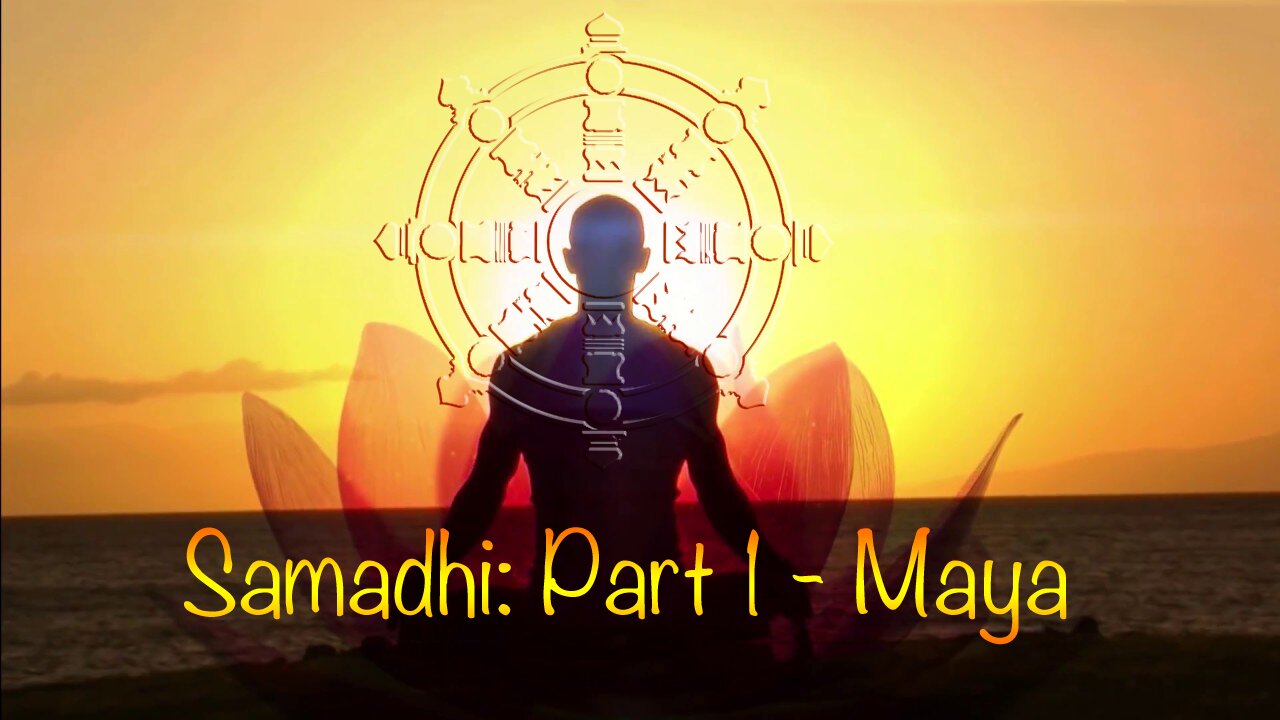Premium Only Content

Samadhi (2017) Part 1 - Maya 🙏🏼
When Soul and body are in the bond of Love, they can be kept together. By concentration on the breath, it is brought to perfect elasticity, and one becomes as a babe. By purifying oneself in Samadhi, one becomes whole. In his dealing with individuals and with society, let him move without lust of result. In the management of his breath, let him be like the mother bird. Let his intelligence comprehend every quarter; but let his knowledge cease. Here is the Mystery of Virtue. It createth all and nourisheth all; yet it doth not adhere to them. It operateth all; but knoweth not of it; nor proclaimeth it. It directeth all, but without conscious control.
🙏🏼
TO ALSO WATCH THE OTHER 2 EPISODES OF SAMADHI
🔻
🎥 Watch: Samadhi (2018) Part 2 - It's Not What You Think 🙏🏼
https://rumble.com/v26dthc-samadhi-2018-part-2-its-not-what-you-think-.html
🔻
🎥 Watch: Samadhi (2021) Part 3 - The Pathless Path 🙏🏼
https://rumble.com/v26au06-samadhi-2021-part-3-the-pathless-path-.html
👇🏼
Additional:
🔻
🎥 Watch: Choice-less Awareness
https://rumble.com/v28b9g8-choice-less-awareness.html
.
The name, named, is not the eternal Name. Nameless, the origin of heaven and earth. Named, the mother of ten thousand things. Ever desireless, one can see the mystery. Ever desiring, one sees the manifestations. These two spring from the same source, but differ in name. This appears as darkness. Darkness within darkness. The gate to all mystery.
.
When action is pure and selfless, everything settles into its own perfect place.
.
The Tao resembleth the emptiness of space; to employ it we must avoid creating ganglia. Oh Tao, how vast art Thou, the Abyss of Abysses, Thou Holy and secret Father of all Fatherhoods of Things. Let us make our sharpness blunt; let us loosen our complexes; let us tone down our brightness to the general obscurity. Oh Tao, how still art Thou, how pure, continuous One beyond Heaven. This Tao hath no father; It is beyond all conceptions, higher than the highest.
.
In Buddhism samadhi is the last of the eight elements of the Noble Eightfold Path. In the Ashtanga Yoga tradition, it is the eighth and final limb identified in the Yoga Sutras of Patanjali.
.
Understanding Samadhi
The Samadhi definition is the mind being completely absorbed in a single object of meditation. The mind can identify itself with the meditation object. In Samadhi, there is no mental and physical consciousness, no hearing or seeing, there is spiritual consciousness only. You can say this is a state where the mind experiences deep-rest. Sleep is not Samadhi as this is unconscious rest, Samadhi is a state of conscious rest. This Samadhi can be termed as super consciousness, supreme bliss and enlightenment.
.
The path to Samadhi is not the sort of path where one puts one foot in front of another in order to get to some destination. The path is a stripping away of illusion, a letting go of identification with a limited self, so that one wakes up exactly where one is.
.
The ancient mystics, yogis and seers have said that everything is primordial awareness, or non-dual consciousness which is simultaneously emptiness and form (all that is). Primordial awareness is not what we normally refer to as consciousness; it is what is aware of consciousness as it changes from one state to another. In so-called “normal” life we are aware of three states of consciousness; waking, dreaming and deep sleep, and these states come and go. Primordial awareness is aware of the coming and going of these states, but it does not come and go. In Vedanta it is called turiya, the fourth state, the ground of your existence. It is always aware and yet is not separate from what is observed.
.
The mind might ask “how can I realize myself as this pure awareness?” The desire to capture the truth always comes from the egoic mind which wants to acquire awareness, but it can never acquire it because it is the very thing that has to surrender for it to be realized. Prajna or wisdom of the truth is waking up to what is always already present. If you are not careful, the mind can lead you down a path of endless seeking in an attempt to add more to yourself. Liberation is the end of seeking, and the realization of the false self that is trying to attain something.
.
Do not seek enlightenment or extraordinary states of being, since all seeking is the activity of the ego. Simply cease valuing and chasing illusions, and the source will reveal itself..
.
Turn awareness away from the illusion towards awareness itself and allow everything to be as it is until you have realized the true Self or God, which is the awakened consciousness that does not come and go. From the perspective of the dual world, there are two parts or two paths to Samadhi. Yin and Yang together form an inseparable unified totality. There is no Yin without Yang, just as there is no cup without the emptiness inside. The two aspects of existence are that which changes, and that which does not change. The ground of your being is perfect in its nondual empty-fullness, eternal in its dynamic stillness, unbound as it exists everywhere and nowhere. The pathless path is to realize an ever-deepening development process within the self structure, and to simultaneously realize our true nature, which is the primordial awareness beyond name and form. Samadhi is when the world that is constantly changing merges or unites with the changeless. Even that is not entirely true; nothing actually merges because nothing was really separate. The illusion of separation falls away revealing that everything has always been that one primordial consciousness.
.
The world of one who is suffering in Samsara is identical to the world of one who is awakened, except that the former is mediated by the false self. In Christian terms you could say that when one is identified with the limited self it is hell, and when one is free of the limited self, it is heaven. Jean-Paul Sartre famously said “Hell is other people.” When this statement is examined deeply, a profound truth is revealed. Whenever there is any kind of distinguishing between self and other, then one is in hell, which is nothing but the cycle of egoic activity (craving and aversion). Hell is identification with the limited self, which is the creation or coming into being of the duality of self and other.
.
When one awakens, one realizes with a direct knowing that “I am not this limited mind/body”. This knowing, once recognized and established in the mind, may give the ego a feeling of relative freedom from its own conditioning; a sort of loosening of the chains. There may be a sense of lightness and understanding that you are not this limited character, and that you are not obliged to follow the script that has been set out for your life. Yet this very conviction can become the basis for a new character or new spiritual persona. If you continue to say “I am not this limited mind/body, I am awareness”, then there is a split, a duality or separation between awareness and the mind/body. This separation is the false delusion created by the limited egoic mind and you can be sure that your path has been appropriated by the false self.
.
In the world we live in today, most people’s lives are limited to the physical and mental sheaths of the soul, and when they get a glimpse of what is beyond these levels their consciousness often gets pulled back down into the mind/body illusion. Because the habit pattern of the mind is so strong, most people will make up a story or narrative about their awakening experience. One must be vigilant that we do not become identified with being a person who is awakened or enlightened, for this is the greatest delusion of all. As the Zen master Suzuki said “There are, strictly speaking, no enlightened people, there is only enlightened activity.”
.
Do not mistake understanding for realization (realization is the actual awakened state).
And do not mistake realization for liberation (liberation is the awakened state that does not come and go).
.
Your mind literally can’t imagine where the path leads. Limited mind will be your greatest obstacle. In fact your identification with the limited mind will be your only obstacle on the pathless path. Virtually everything in the world is pointing us in the opposite direction towards the level of language and conditioned thoughts that make up the so-called external world. We are conditioned to seek solutions outside of ourselves and as long as we are seeking we will remain within the labyrinth of mind and will never come to inner stillness. Yet when one awakens, one’s true nature is revealed to be the very essence of mind. The only difference is that awakened mind is unlimited, while egoic or personal mind is limited.
.
“To seek is to suffer. To seek nothing is bliss.”~ Bodhidharma
.
Socrates is famous for saying “I know that I don’t know”, and that not-knowing is what made him the wisest man in Greece. He does not know and thus he has found the Way. The most important thing the lower mind can learn is its limitation with regard to the path. Realizing the mind’s limitation is not the same as realizing the truth, but it is the necessary first step. One must stop the futile, incessant activities that keep one seeking some knowledge, transcendent state or experience, or some “thing”. Truth is not found by answers or attainments on the level of mind, but within the unfathomable non-dual empty-fullness of the heart. It is realized when questioning ceases. You can’t “get” or acquire the truth, you only wake up to the truth through Samadhi, through the alchemy that dissolves the self when one single-pointedly, adamantly refuses to respond to illusions. It is through the negative path, the via negativa that we come to know the truth of what we are, by letting go of everything that we are not. Then it is realized directly that you always have been that ever-present awareness.
.
The legendary teacher Bodhidharma is the founder and first patriarch of Chan Buddhism in China, which later became Zen in Japan. The story goes that Bodhidharma was summoned by the Emperor Wu, who wanted to question him because he heard that he was a great sage.
.
“Who are you, standing in front of me?” asked the Emperor.
“Don’t know,” said Bodhidharma.
.
With this answer Bodhidharma cuts through all of the mind’s tricks and deceptions. It is not that Bodhidharma was an agnostic, believing in the unknowability of his true nature. Bodhidharma was awakened as primordial consciousness, but the limited mind is incapable of conveying it. Words do not convey the silent truth because words are noise. They do not convey stillness because they are movement. The words are a finger pointing toward the moon. Do not mistake the finger for the moon itself. It is not possible to point to primordial awareness .
.
How can you point to that which is everywhere and nowhere? Yet all spiritual teachings are an attempt to do so.
.
From a relative perspective, the mind and senses are filtering and reducing the vibratory field so that we can have a human experience. This stepped-down projection is the simulation of the entire external world, which is mediated through a limited self. All energy and phenomena is spiraled into veils of illusion, the screen or barrier that must be transcended in order to awaken to the truth directly. Even the apparent transcending of illusion is an illusion. Those who have realized their true nature have said that there only appears that there is a barrier between you and primordial consciousness, since actually everything is that consciousness. As long as the illusion of a limited self persists, one plays a game of hide and seek with awareness. Even though we may understand mentally that the entire self structure is illusory, we remain entangled in the illusion, still responding to preferences and conditioned constructs as craving and aversion arises. To penetrate to its depth takes great vigilance and one must want awakening more than the illusion, more than life itself.
.
If all is illusory, then why not just remain single-pointedly aware of awareness, turning awareness back on itself and ignoring the illusion? This is easier said than done. For most of us the illusion is extremely persistent and one’s peace is constantly disturbed by the fluctuations of the mind (the vrittis or the “whirlpool” of the mind). As soon as we try to quit our conditioned patterns the inexorable gravity and inertia of the matrix will pull us back into its spiral of maya. The well-worn grooves of conditioned patterning are established and energy will default to running in these old channels unless there is an interruption and rerouting of the wiring. The path is to purify both the biological conditioning and the conditioning that has been inherited socially. Within our biological conditioning is the deepest response-to-stimulus impulse that becomes sublimated to higher and more complex levels of thought and behavior. Our social conditioning is built on top of primitive impulses and wired into the reptilian conditioning that is at home in the reptilian brain.
.
On the path we bring to light the patterns hidden in the unconscious, and there are also supra-conscious stages of evolution that one is similarly not aware of because they have not emerged out of one’s inner growth. The supra-consciousness is like a flower that has not yet bloomed and we don’t know what it will look like.
.
There is an old proverb (in Sanskrit called Kupamanduka) about a frog that lives its life in the bottom of a well. The frog believes that the well is the entire world. It explores every pebble within the well and measures it in all directions, so it is with supreme confidence that the frog speaks about the totality of the world. One day a fish falls in the well and tells incredible tales about the outside world and swimming in the vast sea. The frog literally cannot comprehend nor imagine it, so he rejects the stories as either lies or madness.
.
We are like the frog in the well. We don’t know what we don’t know.
.
The unconscious is exactly that; not conscious. If we knew what it was, then it would be conscious. We cannot drop or become free from a pattern that we hold which we are not conscious of. There are parts of ourselves that are hidden, operating unconsciously within our animal nature; deep craving and aversion connected to the reptilian brain and sublimated within all aspects of behavior and life. And there are aspects of us that are supra-conscious operating within templates or structures on the higher soul levels, but we have not established the connections to these subtle realms.
.
We have the opportunity in this life to go farther and to go deeper. The enlightenment process takes us farther into the expanses of cosmic mind while awakening takes us deeper into the present moment. As we walk the path we will likely have times that we are not awake; identified with some aspect of the illusion. The pull of the spiral of maya is strong. In addition to formal meditation and self inquiry practices, we can use every moment of our lives to become more aware, to become more free. This happens naturally when we finally stop responding to illusions. When we stop responding to illusions there is friction generated within the self structure as the old patterns die, resulting in transformation and the birthing of higher levels of consciousness. You become the dead soil out of which the next level of you grows. In the enlightenment process, the sense of you continues to expand, to encompass more and more of mind/maya and higher levels of self, until it is identical with all that is (ultimately awakening as non-dual reality). From the relative point of view we continue to work to become free, even if from the absolute perspective our true nature is always already free. This is the pathless path.
.
Steps for achieving Samadhi:
Following the steps listed below you can reach the state of Samadhi.
.
1. Commit yourself to take a minute every day to accept that you are grateful and appreciate something. You do not need a long list, a single thing will do. In simple words, be grateful for the life you are leading as there is always a positive to negate the negative and it is advisable to concentrate on this positive.
.
2. Pranyama also known as conscious breathing needs to be done every day so that you are aware of each breath you take. You need to understand that only our breath is the ‘present’ you experience. This can be done for only 5 minutes every morning. Make sure you focus on your breath and be aware of the different vibrations. This can calm your mind totally.
.
3. Samadhi also means self-realization, which means, knowing yourself better. This is accepting yourself for where you are at present. Learn to respect and accept yourself so that you can do the same with others.
.
4. According to the yoga sutra, it is important to relax and make less of an effort and meditate on all the energy within you. In simple words, you need to slow down and try to stay in the flow of your life.
.
5. It is important to do things that can feed your mind as Samadhi is equality. You need to feed your emotions and your soul.
.
In order to contemplate Samadhi you need to meditate in a seated posture like Easy Pose or the Lotus Pose.
.
Two Stages of Samadhi:
Samadhi has two stages, Sabikalpa and Nirbikalpa. Sabikalpa is a state of oneness conditioned. The mediator can experience the merger between the soul and the infinite consciousness. This state cannot be preserved outside the meditation. Sabikalpa is the initial break from delusion where the mediator realizes that the soul is bound by the ego and only God exists. There are few souls who tend to return to delusion from this state if they hold on to the delusion that they have infinite power. Nirbikalpa is unconditioned oneness. Here the soul can rise above the bondages of the ego and can realize that it is only one with God eternally. It is jeevanmukta. In order to achieve this total liberation from the involvements of the ego the soul needs to go through the different memories of attachments of the ego. There is no way the soul can return to delusions.
.
Samadhi, also called samapatti, in Hinduism, Buddhism, Jainism, Sikhism and yogic schools refers to a state of meditative consciousness. It is a meditative absorption or trance, attained by the practice of dhyana. In samadhi the mind becomes still. It is a state of being totally aware of the present moment; a one-pointedness of mind.
.
In Buddhism, it is the last of the eight elements of the Noble Eightfold Path. In the Ashtanga Yoga tradition, it is the eighth and final limb identified in the Yoga Sutras of Patanjali.
-
 LIVE
LIVE
The Big Mig™
2 hours agoViolence & Burning The U.S. Flag, Democrats New Battle Cry
5,185 watching -
 27:39
27:39
Crypto.com
1 hour ago2025 Live AMA with Kris Marszalek, Co-Founder & CEO of Crypto.com
5.35K -
 LIVE
LIVE
The State of Freedom
2 hours ago#327 Digging Deeper into the Carbon Capture Scam w/ Brad LeBlanc
27 watching -
 38:39
38:39
VINCE
3 hours agoThis Is How The Media Spins The News | Episode 111 - 08/26/25
42.9K41 -
 LIVE
LIVE
Badlands Media
8 hours agoBadlands Daily: August 26, 2025
4,036 watching -
 LIVE
LIVE
GritsGG
2 hours agoWin Streaking! Coloring Hair at End of Stream! Most Wins 3435+ 🧠
163 watching -
 1:56:45
1:56:45
Dear America
3 hours agoNO MORE BURNING FLAGS!! 🇺🇸 Trump Signs Order Making It ILLEGAL!! + Trump Is SUING NEWSOM!
73.8K58 -
 LIVE
LIVE
JuicyJohns
3 hours ago $0.64 earned🟢#1 REBIRTH PLAYER 10.2+ KD🟢
107 watching -
 1:56:23
1:56:23
Law&Crime
2 hours ago $0.63 earnedLIVE: Adelson Matriarch Murder Trial — FL v. Donna Adelson — Day 3
10.7K -
 LIVE
LIVE
Major League Fishing
4 days agoLIVE! - Fishing Clash Team Series: Challenge Cup - Day 3
168 watching